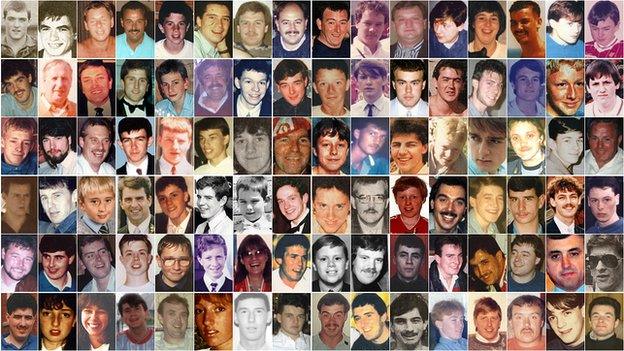Hillsborough inquests: Ambulance man walked past fans 'in significant need'
- Published

Fans started climbing off the terraces just after kick-off during the 1989 match
An ambulance officer at Hillsborough walked past fans who seemed to be "in significant need of help", an inquests jury has heard.
A lawyer for some of the Hillsborough families suggested Stephen Chippendale "could" and "did" see fans more in need of treatment than the first he treated.
But Mr Chippendale said he did not see anybody who needed resuscitation until after that casualty had been seen.
Ninety-six people were fatally injured in the stadium tragedy in April 1989.
The jury at the new inquests heard the Liverpool versus Nottingham Forest FA Cup semi-final was Mr Chippendale's first match on duty at the stadium in Sheffield.
He was one of the most junior qualified ambulance officers based at Sheffield's Longley Ambulance Station.
He said he was not given a tour of the ground by the two senior officers who were also there, station officers Patrick Higgins and Paul Eason, and he did not know about an emergency plan for the stadium.
'Five minutes of fame'
The officers' attention was drawn to the Leppings Lane end of the ground when fans started climbing off the terraces just after kick-off at about 15:00 BST.
Mr Chippendale said: "I thought it was just, well, the usual idiots trying to climb on to the pitch, get their five minutes of fame."
The jury heard Mr Chippendale and Mr Eason set off for the Leppings Lane end between 15:02 and 15:03.
Mr Chippendale added: "We looked around to see if anybody was injured. We saw the police. At that time they were pushing the crowd back... from over the fencing back in to the stadium again.
"They thought the same thing - they were trying to do a pitch invasion. We were looking around assessing if anybody injured themselves jumping on to the pitch."
The two ambulance men walked in front of the pens and found a man near the goal with a suspected broken leg.
Mr Chippendale said he was punched on the shoulder during that walk but was not concerned for his safety.

Who were the 96 victims?

BBC News: Profiles of all those who died

He said it was only after he finished treating the man with the leg injury that he saw people giving heart massage and mouth-to-mouth to injured fans.
But Jo Delahunty QC, who represents a group of Hillsborough families, argued that he noticed fans injured in the pens earlier.
Ms Delahunty showed a picture timed at about 15:05 showing the two ambulance men walking in front of the pens.
Mr Chippendale confirmed he appeared to be looking towards the pens.
'Clearly in difficulties'
The barrister said that in the pens there were "images there of people who appear to be in need of significant help".
She said they were separated from Mr Chippendale by the mesh fence and were "clearly in difficulties".
Ms Delahunty said: "What I'm suggesting is not only could you see what was happening behind those pens, but you did see what was happening behind those pens because we can track your progress."
Mr Chippendale replied he was "assessing the whole area", not just the pens.
Ms Delahunty continued: "This is the closest you got to the pens that we can see over the course of the afternoon and therefore when you say you could see fans squashed against the fencing, that must be the period that you're meaning."
Mr Chippendale said he could see the logic of that statement.
Ms Delahunty then asked: "So, do you accept that you did see people in serious difficulty behind the pens at that point?"
Mr Chippendale said: "Looking at the photograph there, yes."
Asked why a major incident was not declared at about 15:05, he said: "I assumed Mr Eason had done it already."
The jury has previously heard how Mr Eason declared a major incident at 15:22 that day from an ambulance radio.
Jenni Richards QC, who represents the Yorkshire Ambulance Service, said in Mr Chippendale's 1989 statement he had said he only noticed people in distress after dealing with the suspected broken leg.
The inquests, in Warrington, continue.